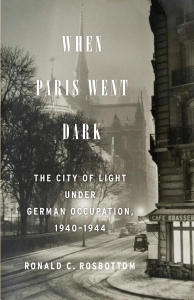Arts Week
Ambiguity in the Darkness
 There are many stories about what happened in France during the German Occupation—almost as many stories as there were people who lived them. For some, France was filled with resisters who sabotaged the Nazis at every turn. For others, it was about the shame of collaboration. The truth, as is often the case, is both broader and more complex than either of these extremes would suggest.
There are many stories about what happened in France during the German Occupation—almost as many stories as there were people who lived them. For some, France was filled with resisters who sabotaged the Nazis at every turn. For others, it was about the shame of collaboration. The truth, as is often the case, is both broader and more complex than either of these extremes would suggest.
I know; my family lived in France through the second world war, and, like most French families, has troubles articulating its role in the four years of the Occupation. Those years (and the strange ways in which they affected the nation’s consciousness) are explored in When Paris Went Dark, by American professor and author Ronald C. Rosbottom, and the ambiguities outlined:
“Even today, the French endeavor both to remember and to find ways to forget their country’s trials during World War II; their ambivalence stems from the cunning and original arrangement they devised with the Nazis, which was approved by Hitler and assented to by Philipe Petain, the recently appointed head of the Third Republic, that had ended the Battle of France in June of 1940. This treaty — known by all as the Armistice — had entangled France and the French in a web of cooperation, resistance, accommodation, and, later, of defensiveness, forgetfulness, and guilt from which they are still trying to escape.”
On June 14, 1940, German tanks entered a silent and nearly deserted city. Eight days later, France accepted a humiliating defeat and foreign occupation. Subsequently, an eerie sense of normalcy settled over the City of Light. Many Parisians adapted themselves to the situation, even allying themselves with their Nazi overlords. At the same time, amidst this darkening gloom of German ruthlessness, shortages, and curfews, a resistance arose. Parisians of all stripes—Jews, immigrants, adolescents, communists, rightists, cultural icons such as Colette, de Beauvoir, Camus and Sartre, as well as police officers, teachers, students, and store owners—went from small acts of resistance to overt acts of terrorism.
Paris in those years was “a city where many, many young and middle-aged men were in prison, concentration camps, in hiding, or in the underground,” so almost by default the Resistance became in significant measure a movement of the young and of women and girls, without whom “the Parisian resistance, no matter its ideology, could not have been as successful as it was.” And in the middle of all this, there remain “the ethical questions that would haunt France for decades: Which actions, exactly, constitute collaboration and which constitute resistance?”
One of the most often-asked questions about the Occupation of Paris concerns how and when its citizens resisted the imposition of a foreign host. Why was the city surrendered without a shot being fired? What sort of organized resistance developed? How unified were the different groups who did resist? What forms did that resistance take, and why was it not more successful? In the end, is it true that the French were more passive than active in their acceptance of German authority?
The main character of this book is Paris, both the geo-political site as well as the imagined one. There are many, many references here to specific streets and boulevards, métro stops, neighborhoods, monuments, restaurants, cafés, churches, museums, cemeteries, parks, hotels and more.
In some ways, this is a retroactive guidebook, for the city that the Nazis occupied has not changed much in the last seventy years. The other story is how two complex national and cultural entities—Parisians and Germans—reacted to each other, how they lived in an intimate embrace where the moves or caresses of one brought forth a reaction from the other. Neither was strong enough to control the other, but slowly, because of fatigue rather than strength, one finally manages to break away.
The story of the Occupation of Paris fascinates us the same way that fictional works imagining the Nazi occupation of London or New York do. How can a city so well known—thanks to poetry, fiction, history, film, painting, photography, postcards, songs and the innumerably recounted visits of thousands upon thousands of world tourists—adapt to a sudden jolt that, unlike an earthquake or even a plague, lasts much, much longer than expected?
It’s not a comfortable read, but it’s an important one. Thanks to the author’s tireless research and interviews with hundreds of Parisians, the reader is able to enter into the experience, ambiguities and all. Highly recommended.












